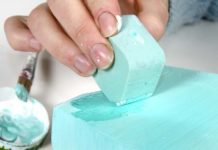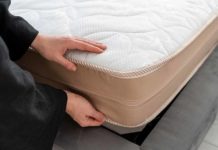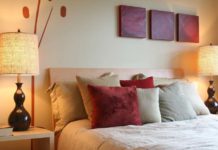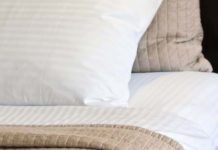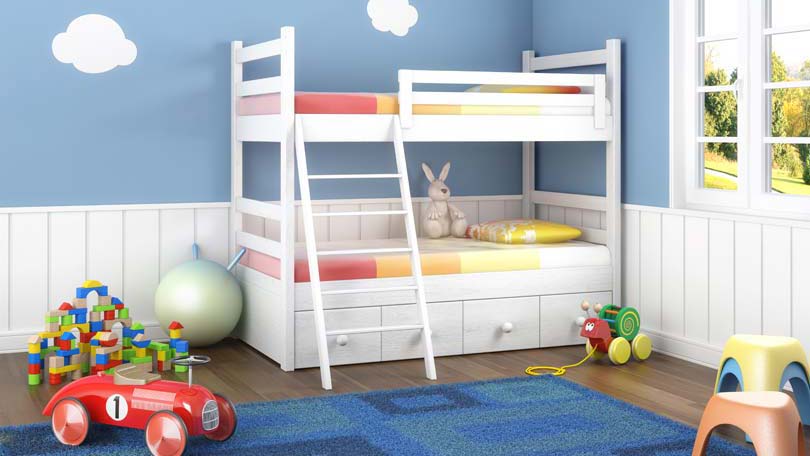
Bunk beds are great for little people, not only to save space, but to extend space as well. But when choosing a bunk bed for your child, you need to take a number of factors into consideration, from safety to style, and of course cost.
The Concept of Bunk Beds
While a bunk is essentially a narrow shelf-like bed commonly found on ships, boats and yachts, bunk beds are pairs of beds – usually freestanding – that are constructed one above the other. They are commonly used in children’s rooms, often to save space.
Essentially a place to sleep, this type of bed can also become an indoor play structure, providing it is safe.
At its simplest it is a wooden or metal framework with the top bed either directly above the bottom one, or with the two set at right-angles to one another. At its most elaborate, a single bunk bed can become part of an intricate furniture design that incorporates storage, display shelves and often a desk unit.
If used as an integrated play unit, the bed structure will incorporate ladders and other fun features. A rope ladder might be included, or a slide, provided of course there is a soft and safe landing below it.
Safety Considerations for Bunk Beds
You should always put safety considerations first when you plan an environment for your children. Young children are generally imaginative and inquisitive, which is great for creativity, but not necessarily for safety. While some certainly do have common sense, this doesn’t always come naturally.
Children under the age of six should never be allowed to sleep in a top bunk. Once they are asleep, they could easily topple out of the bed, even if it has a safety rail. They might also try to climb out of the bed in a sleepy state and fall. For this reason having bunks can be a problem if two children of different ages share a bunk bed unit. In any case it is good practice to have thick-pile carpeting under and around these beds to minimize injury if a child does fall off.
If you are choosing a bunk bed for your child, it is vital to make sure that ladders and custom-made adjacent steps are always secure. A freestanding ladder can be a hazard because it has no way to remain permanently attached to the bed.
Then there’s the question of the finish applied to this piece of furniture. If the framework of beds is painted, it is important to make sure that the paint is non-toxic. Little children, especially very young children, often bite furniture, even if they are told not to.
All surfaces should also be smooth, without any sharp ends or edges. If a wooden unit is screwed together, the screws should not stick out otherwise they can easily scratch the skin.
If you live in the USA, be sure to only buy products that meet current ASTM standards. Since there aren’t any specific safety standards in Canada and some other countries, try to find products that meet the American standards.
Bunk Bed Options
Many companies manufacture designs that you can buy off-the-shelf. Some offer custom-made designs that you can have adapted, depending on your needs. The third option is to design or have a set of beds designed by a professional. This last option will appeal to those who have very specific needs, or those who want built-in furniture. It can, however be an expensive option, and may not be able to “grow” with the child.
Rooms that can “grow” with the child
Children grow up incredibly quickly, and a challenge for parents is to be able to change the room as needs change – without changing every item of furniture and all the soft furnishings. So, for instance, if bunks are something that appeals to you or your little ones, you will only introduce them to the bedroom scheme when your child or children are at least four or five, or when they go to school. If you have one child, you could use the bottom bunk, but you’d need to be sure that there was no access to the top one for the time being.
Unless you opt for built-in beds, or bunks with a bottom bunk that has been customized in the shape and form of say a car or boat, modular bunks can usually be dismantled and then turned into two regular beds. This makes them reasonably long lasting and versatile.
What you can Buy off-the-shelf
When it comes to choosing a bunk bed for your child you will find that off-the-shelf furniture is relatively predictable. Most are sold without mattresses.
Some Popular Options Include:
- The Mydal and Norddal bunk bed frames from Ikea which are made of solid pine, with the two beds mounted one on top of the other. Recommended for children aged seven and older, these designs have a typical slatted bed base and a secure ladder.
- The epoxy-coated Tromsö beds, also from Ikea, are also intended for children aged at least seven. There is also a pull-out bed in this range that could be stored under the bottom bunk, giving an additional facility for friends sleeping over.
- A range of different solid hardwood designs from Riddle. All are made from maple, aspen or alder and are available not only for children, but for adults too. Some are made in double bed size, increasing their versatility. All these designs have slats that support mattresses. Most have built-in sides that people can climb up.
- If you don’t feel like going shopping as such, you can even order bunk beds off the Internet, for example from GoWFB.ca. One of this company’s particular popular designs has a three quarter bed below a single bed – ideal for having friends sleep over.
The best advice is to shop around until you find exactly what you are looking for.

